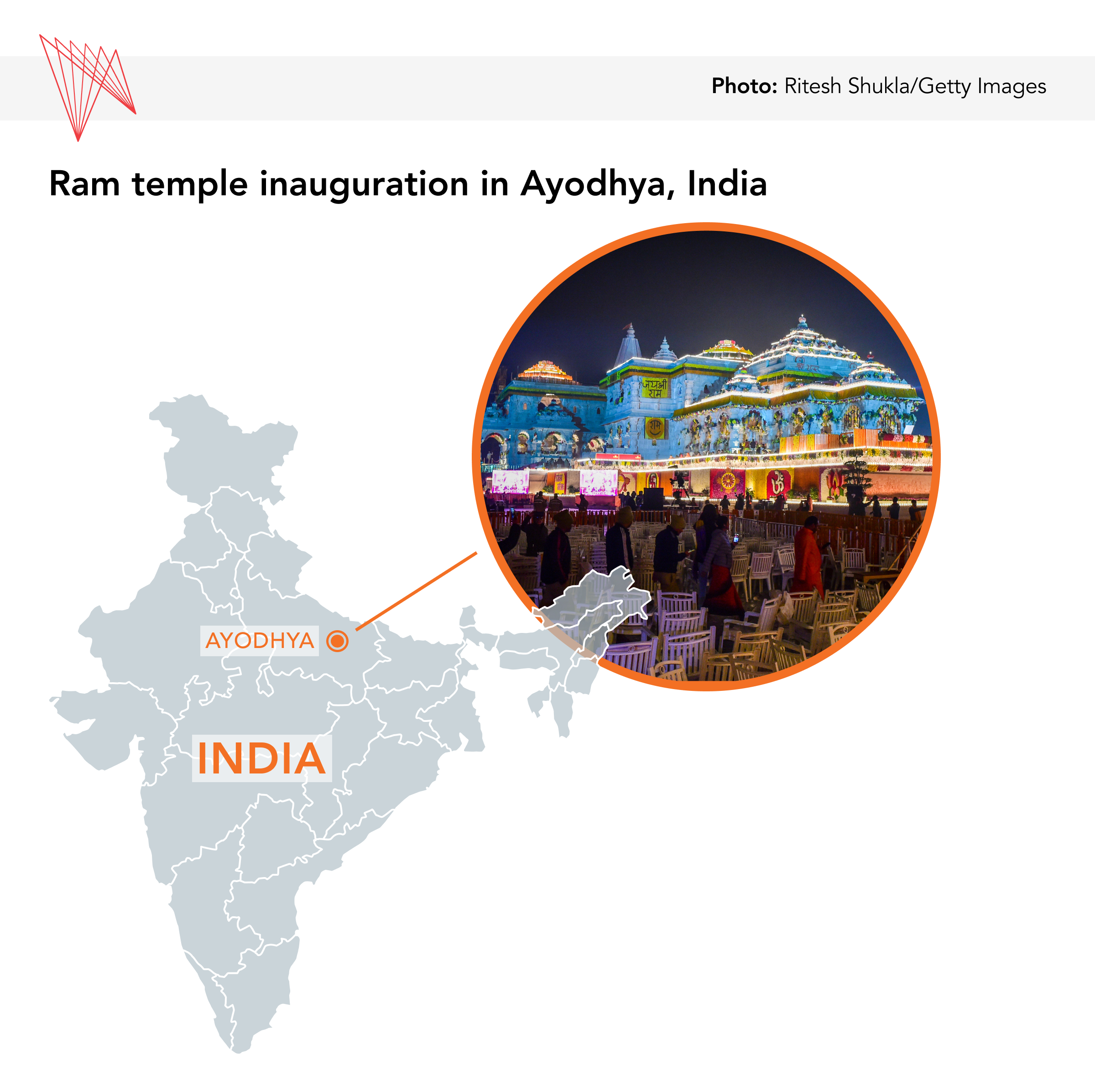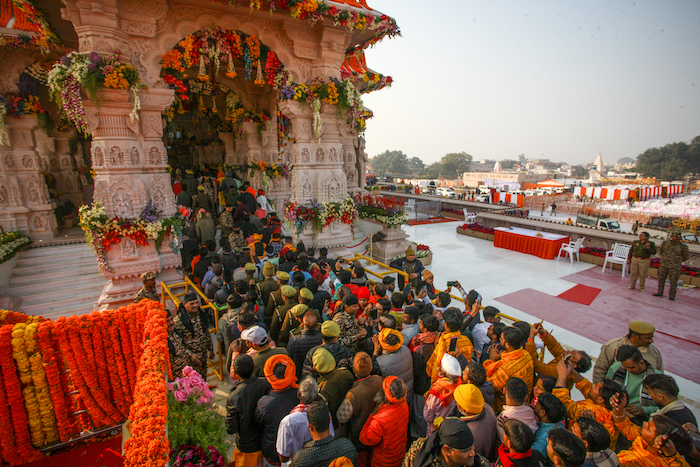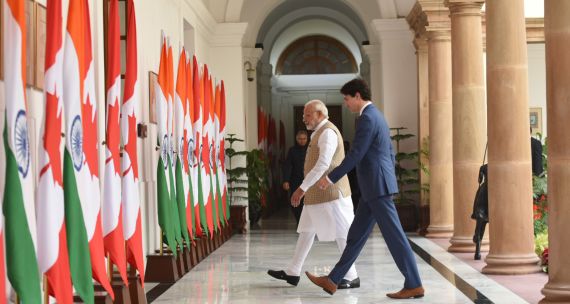On January 22, Indian Prime Minister Narendra Modi, accompanied by the country’s top business personalities, celebrities, and sports stars, consecrated a monumental temple for the Hindu deity Lord Ram in the city of Ayodhya, Uttar Pradesh. In doing so, Modi fulfilled a decades-old political promise to the country’s Hindus, who represent roughly 80 per cent of the Indian population.
This promise helped catapult Modi’s ruling Bharatiya Janata Party (BJP) to national prominence in the 1990s and bolstered its popular appeal among the Hindu population. The extensive fanfare around the inauguration of the Ram temple is a sign of the BJP’s solidification of this appeal. It is also, however, a harbinger of further corrosion of the country’s commitment to a secular ethos, as captured in its constitution.
India is the world’s largest democracy and a growing economic powerhouse. It is also increasingly portrayed as a ‘Hindu nation’ rather than a multicultural and pluralistic society. With this shift, countries like Canada, which in the past emphasized India’s embrace of multiculturalism as a shared value, may have to redefine their relationships with India around a different set of values and interests.
The Ram temple issue also resonates deeply with many Hindus in Canada, who represent 2.3 per cent of the Canadian population. Hindu diaspora communities of Indian origin in Canada have welcomed the Ram temple construction in Ayodhya with vibrant celebrations. Many members of these communities have also expressed strong support for both Modi and his party’s Hindu nationalist ideology. This has deepened divisions among Canada’s diverse Indo-Canadian communities, some of which follow faiths other than Hinduism.

The Ram temple and the history of religious conflict
The new temple is located on the purported birthplace of Lord Ram. It is also a piece of land that has divided Indian politics for several generations. Prior to 1992, this land was the site of a mosque, the Babri Masjid, which was built in the 16th century by Mughal emperor Babur. But in the early 1990s, the Sangh Parivar, an umbrella term for a family of right-wing Hindu nationalist organizations, including its political arm, the BJP, led a nationwide movement to replace the Babri Masjid with a temple devoted to Lord Ram. The movement was premised on the belief that the mosque had been built after the emperor tore down an ancient temple marking the Hindu deity’s place of birth.
As the movement to build a Ram temple gained momentum, on December 6, 1992, a mob of about 75,000 people supporting the Sangh’s campaign climbed atop and flattened the mosque’s three domes with hammers and rods while a rally for a future Hindu temple was underway. What followed was months of widespread communal violence between Hindus and Muslims, resulting in at least 2,000 deaths. Those who committed the crime of demolishing the mosque have evaded punishment; a special court in 2020 acquitted all 32 of the accused, citing insufficient evidence. A year earlier, in 2019, India’s Supreme Court allocated the land to a trust for the construction of the Ram temple. Muslims were provided an alternate location several kilometres away for building a mosque.
New temple tied to the BJP’s meteoric rise
The construction of the Ram temple in Ayodhya became a key part of the BJP’s manifesto just prior to the 1991 national elections. This was against the backdrop of the party’s leadership launching a cross-country rath yatra (i.e. ‘chariot journey’) to Ayodhya in 1990. While incidents of communal violence were reported in the months during the yatra, experts believe that the party’s mobilization around the issue was pivotal in helping it emerge from relative obscurity in the 1980s to becoming the electoral juggernaut it is today.

In 1984, the first year the BJP competed in national elections, it garnered a mere 7.4 per cent of the vote share and two seats in parliament. However, by the 1991 elections, it rose to be the country’s second-largest party, securing 20.1 per cent of votes cast and 120 parliamentary seats, a level of support it maintained in subsequent national elections.
The BJP’s vote share jumped to 31 per cent in the 2014 elections, the year Narendra Modi became prime minister. In the 2019 elections, the party’s support rose further, to 37.4 per cent of the votes, and it won 303 seats in the 543-member Lok Sabha, the lower house of India’s parliament. These impressive electoral successes over the past decade have bolstered the BJP’s perceived mandate to deliver on the core promises it has made since the 1990s. In addition to building the Ram temple in Ayodhya, these include:
- The abrogation of special status under Article 370 of the Indian Constitution for the Muslim-majority state of Jammu and Kashmir, which the Modi government carried out in 2019.
- The creation of a ‘uniform civil code’ that enforces a universal set of laws governing marriage, inheritance, and other matters for all religious communities. This new civil code, the draft of which has still not been released by the BJP, will strip the existing autonomy of minority groups to decide their ‘personal’ laws.
For the Hindu nationalist movement, these goals are central to reversing what they refer to as "minority appeasement” policies embraced by the opposition Congress Party while in power between 1947-89, with a brief interruption from 1977-80.
The ceremony to unveil the Ram temple on January 22, mere months before the next national elections in April-May, has reignited questions about the status of religious and ethnic minorities in a country whose commitment to secularism is enshrined in its constitution. Nonetheless, large sections of the Indian population have welcomed the temple construction, including Indians living in Canada and the U.S., where some members of the Hindu diaspora organized events in local temples and held massive car rallies in celebration of the Ram temple in Ayodhya.
Temple sparks economic boom in Ayodhya
In addition to its spiritual and political appeal, the Ram temple’s construction is being promoted as something that will result in significant benefits for Ayodhya’s economy. In addition to building the sprawling temple complex, the city has secured substantial funding for developmental initiatives, positioning itself as a regional growth centre that is expected to welcome hundreds of thousands of pilgrims and tourists every year.
Ayodhya’s economic ‘makeover,’ which will cost about C$13.7 billion (85,000 crore Indian rupees) over a 10-year period, includes modern roads, a new international airport, and a revamped railway station with greater connectivity. It has even boosted activity in financial markets, sending stocks in Indian railways, hotels, and airline companies skyrocketing. Real estate prices in the city are estimated to have increased five to 10 times compared to rates in place about five years ago.
However, the economic repercussions of the Ram temple’s construction are not all positive. Media reports point out, for example, that some local BJP leaders who allegedly have close relationships with the industries now flocking to Ayodhya have profited from land deals, thereby raising questions of possible conflicts of interest.
Implications for 2024 national elections
While the temple is not expected to be complete until 2027, the decision to inaugurate it just months before voters in India elect a new government seems to align with the BJP's electoral strategy of mobilizing its core support base among the Hindu populace. In tandem, the Modi government has also been touting its commitment to a major economic transformation, showcasing a significant infrastructure push.
The opposition Congress Party, meanwhile, skipped the inauguration ceremony and criticized the ruling party for undermining India’s secular foundations, intensifying the political debate about the role of religion in Indian politics. Nevertheless, several factors place the BJP on a strong footing to return to a third consecutive term in power. These include Modi’s personal popularity and India’s recent growth story as the world’s fifth-largest economy — alongside the party’s traditional appeal as the champion of Hindu nationalism.






